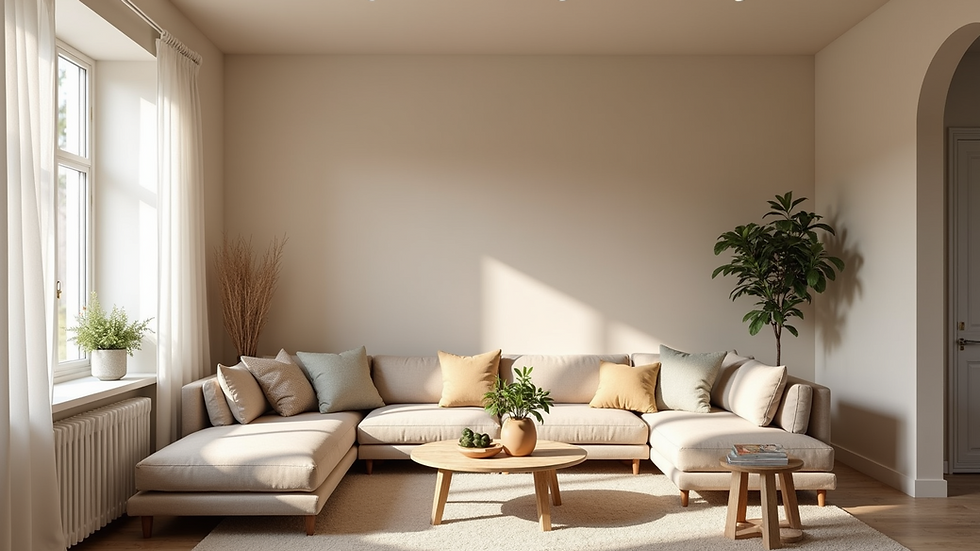Ceiling paint vs wall paint: what to use where (and why) 🎨
- Riley Thorne

- Sep 9
- 3 min read
Choosing the right product saves time, hides flaws, and keeps rooms looking new. This guide breaks down ceiling paint vs wall paint, answers can you use ceiling paint on walls, and shares quick ideas for cool wall paint finishes and colors that actually work in real homes. 🏠
Ceiling paint is formulated to hide and not reflect; wall paint is built to wash and resist scuffs. Pick by purpose, not just color.

Ceiling paint vs wall paint: key differences
Attribute | Ceiling Paint | Wall Paint |
Sheen | Ultra-flat to minimize light bounce and hide texture or patches | Flat, matte, eggshell, satin, or semi-gloss depending on room and traffic |
Viscosity & spatter control | Thicker to reduce drips while rolling overhead | Balanced for smooth rolling and brushing on vertical surfaces |
Coverage goal | Uniform, non-reflective blanket; masks small defects | Rich color with even burnish; designed for touch-ups and blending |
Durability & washability | Limited scrubbing; not meant for frequent cleaning | Formulated for washability and stain resistance |
Color range | Often bright white or tinted white | Full palette, including stain-blocking options and designer lines |
Best use | Ceilings everywhere; especially helpful on textured drywall | Most walls, trim-adjacent areas, and high-traffic rooms |
Can you use ceiling paint on walls?
Technically yes—but it is rarely ideal. Ceiling paint’s ultra-flat finish hides flaws but does not wash well. On low-touch surfaces (e.g., a closet or a rental quick refresh) you can use it in a pinch. For living rooms, halls, kids’ rooms, or baths, choose wall paint in matte/eggshell (for easy touch-ups) or satin (for higher scrub resistance).
When it can make sense
You want a super-flat, gallery look that hides patches on imperfect walls.
A stairwell or vaulted area is hard to reach and seldom touched.
You plan to repaint soon and need a fast, uniform coat now.
When it’s a bad idea
Kitchens, baths, kids’ rooms, and entryways where fingerprints and moisture demand frequent cleaning.
Dark colors—ultra-flat can burnish and show shiny spots after wiping.
Picking finishes and cool wall paint ideas
Matte/Flat: Best at disguising wall texture; choose a “washable matte” formula for family spaces.
Eggshell: The sweet spot for most rooms—soft sheen, easier to clean, still forgiving.
Satin/Semi-gloss: Durable and scrubbable; use in baths, mudrooms, and laundry areas (semi-gloss for trim, not big walls).
Color tips for “cool wall paint”Lean into cool neutrals (soft grays, greige with a blue undertone) for calm, modern rooms. For small baths or north-facing spaces, icy blue-gray or muted sage brightens without glare. Pair cool walls with a flat bright-white ceiling to make rooms feel taller.
Application order and pro details
Prime stains first. Spot-prime water marks or patched areas so they do not telegraph.
Ceiling first, then walls. Roll the ceiling, let it dry, then cut in and roll the walls.
Use the right roller. 3/8-inch nap for smooth walls; 1/2-inch for light texture; 3/4-inch on ceilings with texture to reduce misses.
Maintain a wet edge. Roll top-to-bottom, overlapping by one-half roller width to avoid lap lines.
Lighting check. Rake a work light across the surface; touch up while paint is still wet for seamless blending.
FAQ
In one sentence: what is the difference between ceiling paint vs wall paint? Ceiling paint is ultra-flat and spatter-resistant to hide flaws overhead; wall paint prioritizes washability, color depth, and touch-up on vertical surfaces.
Can you use ceiling paint on walls? You can, but expect poor scrub resistance—reserve it for low-touch areas or super-flat looks, and use wall paint in living areas.
What sheen should I choose for most walls? Eggshell in family spaces, matte in formal rooms with fewer fingerprints, satin in baths and high-moisture zones.
Do I need a special color on ceilings? Bright white or a lighter tint of the wall color keeps rooms feeling higher and cleaner; stick to ultra-flat to hide seams.
Any quick ideas for cool wall paint colors? Try soft gray, blue-gray, or muted sage; they pair well with white ceilings and natural wood for a calm, contemporary look.
Conclusion
Use ceiling paint vs wall paint based on purpose: ultra-flat ceiling paint for a uniform, non-reflective lid; durable wall paint for color, touch-ups, and cleaning. If you’ve been asking can you use ceiling paint on walls, the short answer is only in specific, low-touch cases. For stylish, practical rooms, combine a flat white ceiling with cool wall paint in washable finishes—and paint the ceiling first for the crispest lines.



Comments